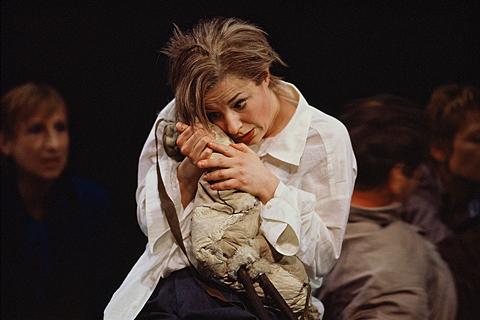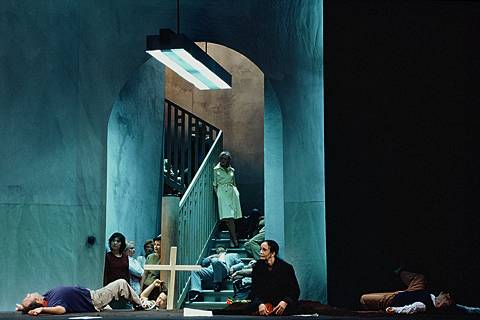|
<< -- 2 -- Roderic Dunnett AN OPERA OF EXTREMES

Now Stuttgart has done it again. Of all the operas awaiting delayed revival, those of the early German twentieth century are arguably the most important. Von Schillings himself wrote Mona Lisa, a shiveringly frightening thriller story of a love triangle opera set in the Renaissance and premièred it here -- managing to catch the claustrophobia of Expressionism even without the trappings of musical Modernism; Schreker's Flammen and Irrelohe both invite belated revivals. So do operas by Wilhelm Fortner and lesser-known Hindemith and Pfitzner.
Stuttgart's 2004 offering is Simplicius Simplicissimus, by Karl Amadeus Hartmann (1905-63), an opera composed in the mid 1930s, at a time when Hitler had scarcely ascended to power, which -- while set during the Thirty Years' War of the seventeenth century -- manages to suggest all the horror of the incineration Europe was to experience half a dozen years later. The product of Hartmann's self-imposed internal exile, it was not heard or staged in Germany till after the Second World War.

Claudia Mahnke as Simplicius Simplicissimus, with bagpipes. Photo © 2004 A T Schaefer, Stuttgart
|
Simplicius Simplicissimus is based on extracts from a seventeenth century novel by Johann Jakob von Grimmelshausen, a kind of Baroque-era Tin Drum in which the central character, the boy Simplicius, a humble, bagpipe-playing shepherd lad set loose in a terrifying world of sacking and pillage, witnesses the devastation, class warfare, human disaster and carnage that universal war can bring. The story has its roots a century earlier, too, in the failed German Peasants' Revolt of the 1520s. The closest analogy is arguably the finest film made about the Second World War, Elim Klima's Come and See, which depicts a similar humble Russian boy caught up between the conflicting Russo-German forces of the Great Patriotic War of 1941-5.
The drama hinges on keeping the scenes/tableaux of Simplicius Simplicissimus simple and the imagery sharp. While not always achieving the second, Christof Nel's production, in intelligently chosen plain modern dress by costume designer Silke Wilrett, hit much the right note. The opera begins with Hartmann's astonishing instrumental prelude -- his orchestra is a modest one, manageable with less than twenty solo performers -- which alone, together with the eerie spoken narration evoking the appalling cost in human life of the Thirty Years' War, lays the groundwork and evokes the mood of the entire opera. The chorus has that air of resigned lethargy and torpor which regularly lowers over those with little or no hope.

Marcia Haydée (Woman) and chorus amid the devastation. Photo © 2004 A T Schaefer, Stuttgart
|
Claudia Mahnke's Simplicius appears by an effective coup de theatre, suddenly thrust to the fore (as if born full grown) by a wrangling mass. Claudia Mahnke's performance began as it continued : Simplicius is, indeed, an incarnation of the medieval Jedermann. Yet he is also a conundrum : terrified yet courageous, shy yet forthright, ignorant yet understanding, uninvolved observer yet totally involved participant, with a massive grain of human compassion.
Continue >>
Copyright © 6 June 2004
Roderic Dunnett, Shropshire UK

|

